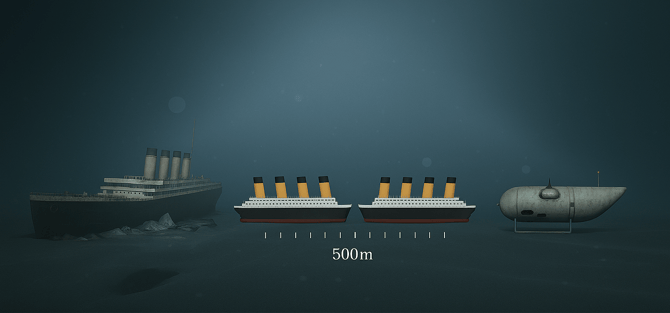Imagine paying $250,000 to visit a shipwreck at the bottom of the ocean. That was the plan on June 18, 2023, when Titan set out for its dive—and never came back. The Titan wreck now lies just 500 meters from another, far older wreck, a century-old symbol of ambition, hubris, and disaster.
Buckle up (or strap into your submersible seat) as we explore how the Titanic disaster of 1912 caused the Titan’s demise in 2023.
Meet Titan: A Submersible Built to Chase History
The Titan was a remarkable little vessel: 22 feet long, made of carbon fiber and Titanium, designed to dive up to 4,000 meters. Inside, there were no seats. Passengers sat cross-legged, peering through a single porthole at the abyss below. It was cramped, unconventional, and experimental—but that was part of the allure.
OceanGate, the company behind Titan, was founded by Stockton Rush, a self-described visionary with a taste for high-risk, high-reward exploration. Rush knew there was one ultimate draw for adventurers willing to pay $250,000: the Titanic. “If you ask people to name something underwater, it’s going to be sharks, whales, Titanic,” he said in 2019.
Titan wasn’t just a submersible. It was a ticket to history, a chance to touch a century-old legend. But the extreme depth came with extreme risk: at 12,500 feet, the ocean exerts nearly 5,000 pounds per square inch of pressure. That’s 400 times the pressure at sea level, enough to crush a submersible if its hull isn’t perfectly engineered…
On June 18, 2023, that risk became reality. Titan’s hull gave way under the immense pressure at 3,356 meters, and all five people onboard were killed in the implosion. The submersible was crushed because of the stresses at that depth, and it was at that depth because it was headed for the Titanic wreckage.
Titan Implosion 5-Why Cause Map™
The next question is, why did the Titanic wreck become such an irresistible target, drawing explorers more than a century after it sank?
The Titanic Wreck Becomes a Deep-Sea Celebrity
In 1985, Robert Ballard and a French-American team located the Titanic, 320 nautical miles off Newfoundland at a depth of 12,500 feet. Overnight, the wreck went from legend to tangible relic. Its fame only grew, fueled by James Cameron’s 1997 blockbuster movie Titanic and countless documentaries. What had once been a scientific milestone became a cultural phenomenon. The wreck wasn’t just for researchers anymore. It became a bucket-list dream for adventurers and tourists alike.
Titan Implosion 6-Why Cause Map™
The Titanic’s fate set the stage for deep-sea tourism more than 100 years into the future. On April 15, 1912, the Titanic struck an iceberg in the North Atlantic and sank, killing more than 1,500 people. It was the deadliest single-ship disaster of its time. That tragedy created the allure. Without the sinking, there’d be no famous wreck to explore, no global spotlight, and—ultimately—no reason for anyone to build a submersible like Titan.
Titan Implosion 7-Why Cause Map™
Two Wrecks, One Lesson
When Titan imploded, its debris settled just 500 meters from the Titanic’s bow, creating a new wreck next to the old one.

Filmmaker James Cameron noted the irony: “Now there’s one wreck lying next to the other wreck for the same damn reason.” Both disasters sprang from overconfidence. In 1912, Captain Smith ignored iceberg warnings. In 2023, Stockton Rush dismissed safety concerns about Titan’s unconventional design.
At ThinkReliability, we use cause-and-effect analysis to learn from failures, and the Titan-Titanic saga is a textbook case. The Titanic’s sinking in 1912 caused the wreck’s discovery in 1985, which led to the rise of deep-sea tourism, which drove OceanGate to build Titan, which imploded in 2023. Each step shows how one event can ripple through time, creating new risks and opportunities.
Here’s the twist: imagine if Titanic had dodged that iceberg. No wreck, no deep-sea tourism craze, no Titan. Maybe OceanGate would’ve built a sub to explore coral reefs instead. The lesson is simple: every effect has a cause, and understanding those connections helps us make better decisions—whether we’re steering a ship or diving to the ocean floor.
Stay tuned for an upcoming blog where we’ll explore the technical nature of the Titan implosion. For now, please comment here if there are any particular aspects of the incident you’d like us to examine. We love to dive into the nerdy details!
















